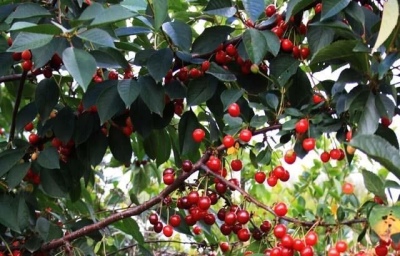
- Authors: Russia
- Barrel type: bush
- Growth type: undersized
- Crown: wide up to 2.5 m in diameter
- Escapes: slender, becoming exposed as the tree ages
- Fruit shape: rounded-flat, with a wide central funnel
- Fruit color: dark red
- Fruit weight, g: 3-3,5
- Pulp color : ruby red
- Pulp (consistency): juicy, medium density
Forming a small orchard at a summer cottage, it is necessary to select the best varieties of trees that do not require complex agricultural technology, but at the same time give stable and abundant yields. Apukhtinskaya cherry must certainly become a part of such a garden.
Breeding history
Cherry Apukhtinskaya is one of the most famous types of folk selection, which has not yet been included in the State Register of Selection Achievements. The history of the tree begins in the Tula region, the village of Apukhtino. There is no reliable information about parental forms, however, cherry is attributed to a relationship with the fruit and berry culture of Morel Lotovaya and Lyubskaya. Recommended for growing a tree in the Central region of the Russian Federation.
Description of the variety
Apukhtinskaya is a low-growing bushy tree characterized by developed skeletal shoots, a shortened and strong stem, a wide, rounded and drooping crown with a slight thickening of light green glossy leaves. Small buds grow away from the tree. In good conditions, the tree grows up to 3 meters in height and up to 200 cm in diameter.
Flowering at the tree is late, falling in the first ten days of June. At this time, the rounded crown of the tree is covered with snow-white five-petal flowers, emitting a light aroma. Ovaries are formed on annual growth shoots. The average life span of a tree is 20 years.
Fruit characteristics
Cherry Apukhtinskaya is included in the category of medium-fruited. On a healthy tree, fruits weighing up to 3.5 grams grow. The shape of the fruit is round-flattened, with a smooth and glossy surface. Ripe berries are evenly covered with a dark red color. Cherry peel is thin, elastic, shiny, not very strong. A deep central funnel stands out on the surface of the berries.
Harvested berries are recommended to be processed or preserved immediately, as they do not tolerate transportation very well. In addition, the keeping quality of cherries is short - this is due to the fact that the stalk is separated from the fruit along with the skin, which violates the integrity and provokes juicing.
Taste qualities
Apukhtinskaya berries have a classic cherry flavor, complemented by a pleasant twist. The ruby red flesh is characterized by fleshiness, medium density and excellent juiciness. The berries have a bright taste - sweet and sour, slightly tart, sometimes there is a slight bitterness. Cherries have a large pit, which occupies more than 10% of the pulp, and is separated very easily.
Ripening and fruiting
Apukhtinskaya is a cherry with a late ripening period, at the same time it is rather early. The tree begins to bear fruit in the 2-3rd year after planting. Cherry fruiting is stable. The phase of active ripening of berries falls on the second half of August.

Yield
Cherry yield is good. On average, 10, sometimes up to 15 kg of delicious cherries can be removed from 1 tree. A characteristic feature is that the yield indicator grows over the years - reaching 20-25 kg.
Self-fertility and the need for pollinators
Cherries are highly self-fertile, therefore they do not need pollinating varieties. It is also worth noting that it is very difficult to choose a donor tree for this variety due to the late flowering time. If you want to increase the yield by 20-40%, then the following cherry varieties can be planted on the site - Zhuravka, Lotovaya, Malinovka, Lyubskaya, Gorkovskaya.
Landing
It is recommended to plant cherry seedlings in early spring, as soon as the ground thaws. Autumn planting is permitted only in the southern regions. It is better to buy two-year-old seedlings with a developed root system for planting. The distance between plantings should be 2-3 meters.


Growing and care
For the cultivation of Apukhtinskaya cherries, a site cleared of weeds is selected (a small hill is possible), where a lot of sun, light and air fall. As a rule, this is the south side of the site, protected from wind and drafts.
Agrotechnology of a tree consists of a chain of activities: regular watering, fertilization, crown molding, removal of dry and damaged branches, thinning, furrowing and mulching of the soil, prevention of diseases and preparation for winter.


Disease and pest resistance
The variety has a high resistance to most diseases of fruit and berry crops. It is extremely rare for a tree to undergo coccomycosis.
Requirements for soil and climatic conditions
Cherry is a thermophilic and light-loving culture that tolerates temperature drops to -18 ... 20 degrees, is not afraid of prolonged drought and heat. Shading, drafts and excess moisture negatively affect the development of the tree.
It is comfortable for a tree to grow in fertile, drained, breathable soils with a neutral acidity level. Sandstone or loam will be optimal. The passage of groundwater must be deep.
































































